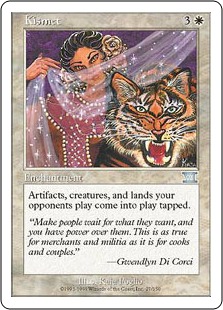When Wizards of the Coast made the Time Spiral block, they pushed the limit on what design could get away with. It proved to be one of the most complex block Magic has ever done, and only Modern Masters in recent years comes close to the number of mechanics, callbacks, and overlapping themes that were present, not to mention color pie experimentation and alternate card frames. It looked at Magic’s past, possible futures, and even an alternate universe or two. It was the set that laid the groundwork for the planeswalker card type, and it was the last time we saw Dominaria.
Magic has been many things over its long history, and that included an overarching storyline for a solid decade. The tales have been numerous and even convoluted at times, but many told the story of the original home of Magic. Before every set was a different plane, Dominaria was home base. Almost every set from Antiquities to Future Sight had some connection to Dominaria and its occupants. It was the place of Urza & Mishra, the Weatherlight crew, and the destination for Yawgmoth’s final invasion. Yes, before planeswalkers were crippled from demigod status and the game’s narrative switched to the Neowalkers we know today, we had this place. Canonically, it was a major hub in the multiverse, with a special resonance to planeswalkers on the whole, before they’ve unofficially made Ravnica the new de facto home base of the game’s planeswalkers.
After the events of the Phyrexian invasion, the influence of the Mirari, and the sapping of the world’s mana from Karona, the designers started to look elsewhere, but after a couple years returned to the nest. Time Spiral radiated nostalgia. In fact, R&D in the long run has deemed Time Spiral to not be overly successful partly because of the set’s complexity, and partly because it had a tendency to make people feel left out from the flavor if you weren’t a dinosaur like me and got all of the references. As a result of these fact – plus the storyline made a mess of the plane all over again – we haven’t seen the homeland in almost seven years outside of Venser, the Sojourner (and look how that turned out).
One of those pieces of nostalgia were the Magus cards. These were fifteen creatures that possessed the abilities of old, iconic (and generally very expensive) cards. Magus of the Bazaar was a callback to Bazaar of Baghdad, Magus of the Moat reflected Moat, and Magus of the Mirror personified Mirror Universe.
It was sentimental seeing old cards made anew, but a creature version of them will always be more fragile than the artifacts, enchantments and lands they embodied. Creature versions can still be advantageous in the right circumstances, but with considerably more creature removal in multiplayer games, the original version is often preferable. Just prior to the Magus cycle of Time Spiral, though, came another creature adaptation: Ravnica’s Loxodon Gatekeeper. And we’re here to look at its originator.
Today we have: Kismet

Name: Kismet
Edition: Legends / Fourth Through Sixth Edition
Rarity: Uncommon
Focus: Lockdown
Highlights: It may be strange to some to think, but other colors besides Blue get occasional lockdown mechanics, and Kismet has been around since nearly the beginning of the game…even if it hasn’t been reprinted since 1999. Forcing permanents to enter tapped is arguably a form of ‘taxing’, something White gets its hands on from time to time. Newer iterations have lost the ability to tap lands, and so Kismet this can be quite advantageous in Commander.
For starters, White is very poor by itself at mana acceleration. Making other players wait that extra turn to cast spells during the early to middle stages of the game buys you valuable time. Whether you’re using it to help shore up your defenses or amass your own army, Kismet can greatly affect a game’s tempo. Case in point: Kismet eliminates the threat of haste creatures looking to make those immediate fist-to-face connections.
However, your opponents likely won’t find Kismet overly infatuating. It slows down the more aggressive decks some, but if a player’s Commander deck also moves slowly (as many do), this can hamper their own efforts even more. Depending on your meta group, how long Kismet survives will depend on politics. Some players will find having this out works in their favor. It could stick around for quite some time if it’s stymieing the frontrunner or simply because for many it’s a minor inconvenience that isn’t worth them wasting their disenchants if they don’t have to as it isn’t that great a threat to them. To others, it will be a meddlesome frustration that must be removed as soon as possible – and likely garner some retaliation.
Still, Kismet is often worth the risk, especially in a monocolored deck. Kismet is mechanically straightforward; the nuance comes from how it’s being wielded. And that part hasn’t changed.
Keep an eye out for us to be regularly featuring other more accessible-but-worth-it Commander cards going forward. In the meantime, we’ll keep the light on for you.
![]()
You can discuss this article over on our social media!
Do you have a particular Commander card to suggest for us to shine a future Spotlight on? You can send suggestions to ryan@cardboardrepublic.com
